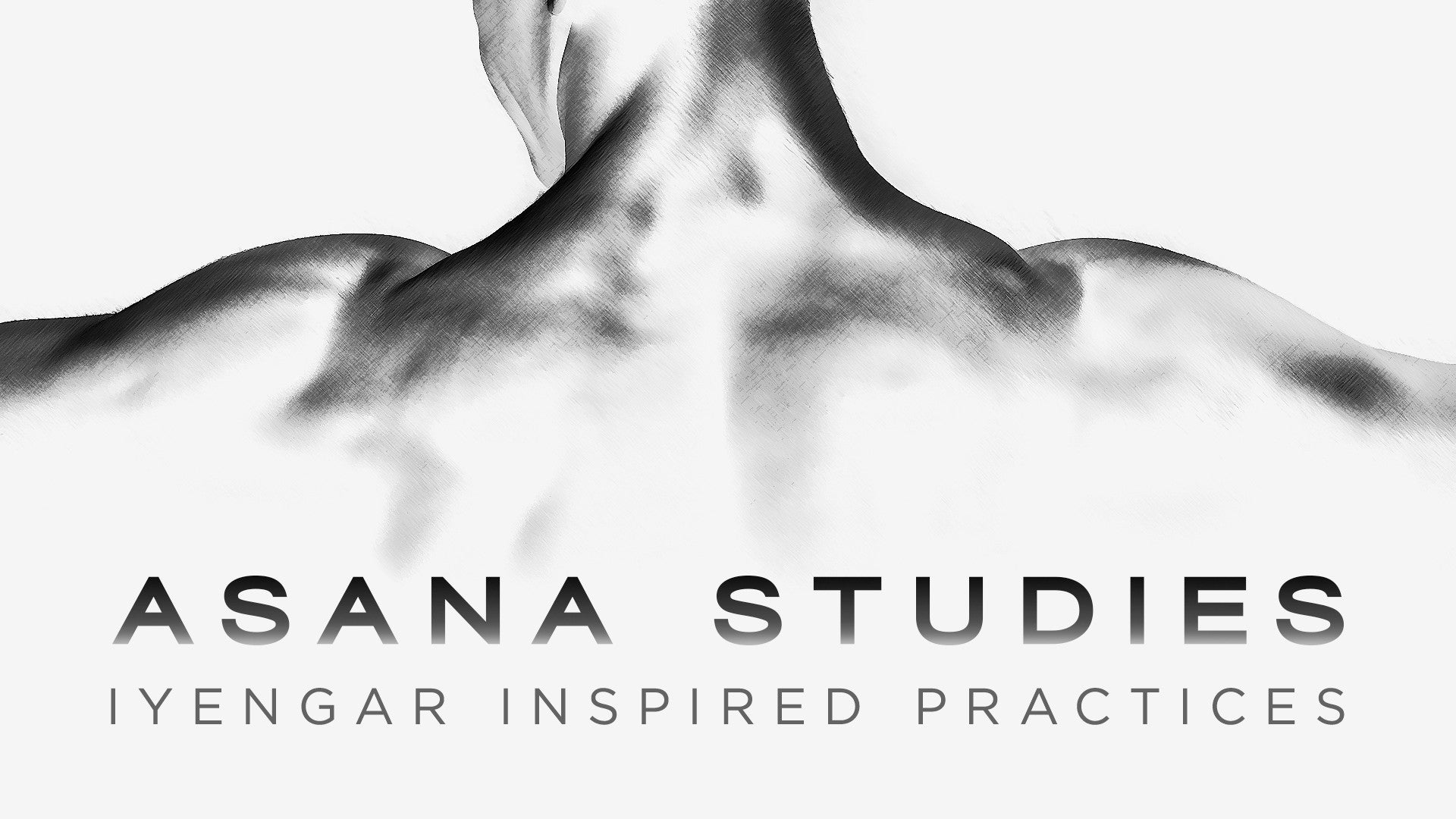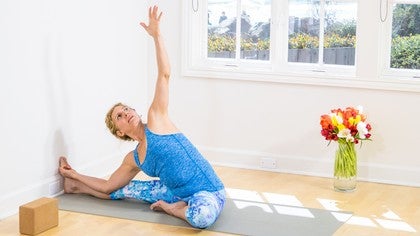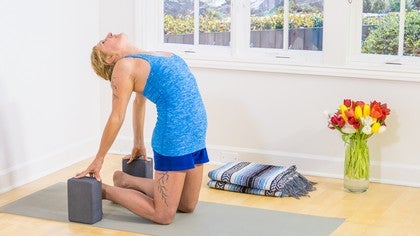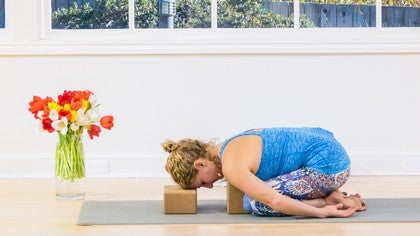Description
About This Video
Transcript
Read Full Transcript
(waves crashing) Hello and welcome, we are going to play with folding and turning the body, side bends and rotations, to affect the nervous system. So, primarily, we'll be working with the relationship of the nerve threading through the tissue. So, the spinal nerves coming out through the vertebral column and threading down through the arms, threading down to the pelvis, to the front of the thigh, threading out from the sacrum, down the back of the thigh. Those are the spinal nerve pathways, and creating some ease in the tissue so that he nerves can easily slide and do their jobs of innervating the tissue around them. The other aspect of the nervous system is the autonomic nervous system, the nerves that move towards the front of the spine and innervate the organs.
So, there's also that relationship of tissue to organ and getting the the nerve innervation to be clear. So, we're going to start quite simply. Actually, let's start here and take a moment with the eyes closed, just to come and find our breath. So, feeling your body, the placement of your body, so how your pelvis is sitting on the floor, how the legs are relating to the pelvis, how the torso relates to the pelvis, the neck and the head relate to the pelvis, and letting your breath drop deep into the body. Good, so let's start in Child's Pose.
So, if you need support under the fronts of the ankles, or behind the knees, grab a blanket. So, I am gonna start with my hands at the front of the mat so that when I sit back, my arms are extended. So, (lightly chuckles) my arm is straight for me, but finding how you can straighten your elbows and move your hips back to your heels. So, letting your head be supported. So, if your head doesn't easily touch the floor, take a few breaths with your head supported in your hands.
And then move the arms back out towards the front of the mat, alright, 'cause we wanna prepare the arms for Downward-Facing Dog. It's spreading the hands into the floor and anchoring the hips back to the heels. And then coming up onto all fours, so the other aspect of the nervous systems, not just the innervation, but the information that comes from the body back to the command center. So, as I, move in through these postures, I'm really trying to find my breath, right, even more important than the shape of the body, but using the shape of the body to reach or find glide or find ease in the body and the breath. And stepping feet forward, hands back to Uttanasana, just feeling that quality of your head releasing down to the floor, that you're quite stable on your legs so your spine and cranium feel like they can hang.
And then finding your breath, lengthening the in breath and the out breath, again, to just send different information back into the system, back into the loop of the nervous system. The sensation moving out and the, the innervation moving, from in, the sensation moving in and the innervation moving out. And then, let's bend the knees, and slowly roll up to stand. And so, we are gonna move to the wall and we will need a block, we also need two blankets and a chair for the rest of the session. So, now that I have my block, so, I'm gonna eyeball how far away from the wall, I'm gonna eyeball about a leg's distance, and then I'm gonna check.
So, I'm bringing my feet together, having the block handy, alright, so, that's about far enough so that my right leg is straight and my left leg can easily find the wall. And then I'm going to turn left leg out to the side, lifting the pelvis up, onto the top of that right leg. So, I'm just gonna focus a little more weight in the big toe side of my right foot, as I bring my right hand on to the block. Stacking the left hip over the right, stacking the left shoulder over the right shoulder, and when I feel balanced, left arm up to the ceiling. Good, feeling quite long, from the base of the pelvis to the crown of the head, so there's a nice sense of length and freedom in the back and in the belly.
Good, and then slowly turning back towards the floor, stepping the left foot down and switching the block to the other side. Right foot comes to the wall, good, turning the pelvis, so the pubis turns away from that left leg. Good, shifting the right hand to the hip, the left hand to the block, stacking the hips, stacking the shoulders. Good, quite long, through the back of the body, through the front of the body, when you're ready, right arm up to the ceiling. Good, so, if you can, eyes, right, I'm looking at you, so my head is slightly lifted, but if you can, bring the eyes straight forward.
Good, front of the chest nice and wide, breath easy. Good, and right hand down, right foot down. Good. Okay, so from here, we're gonna come back down onto the floor, and I'm gonna set us up so we're about an arm's distance away from the wall. And we're gonna ignore the wall, just for a moment.
So, I'm going to start by bending my right knee, taking my right knee out to the side, and then, keeping the left leg where it is, I'm turning the pelvis, just as I did in Ardha Chandrasana, turning the pelvis away from that left leg. So, if your right buttocks doesn't easily come to the floor, you can put a blanket under both buttocks so that you feel like you're seated on something. And you also wanna feel like you're not dropping back on your tailbone, that you're pretty much up on your sits bones. And the back feels pretty neutral, and if this knee is not quite ready to fall to the floor, put something under it, you can use a block, you can use a blanket, this is a big high, I may need something a little lower, okay? So, once you have yourself balanced, I'm actually gonna set my hands back here just to let my body settle, I wanna feel both thighs on the floor.
I wanna feel the base of my pelvis on the floor. And some of this is just to keep the body balanced, to keep the spine neutral, even though I'm gonna then bend. So, keeping that sense of length or neutral, I'm gonna bring left elbow to my knee, and if I can, my head and my left hand. Now, if I'm not quite ready for that, I can use my block, so, just taking time with your breath just to let all of this tissue open, all of these spinal nerves and the tissue right around the spine soften. And then let's take that right arm up to the ceiling and opening the front of that right shoulder, and then taking that right arm alongside the ear.
Good, so, neck nice and long, chin dropped just enough to soften the throat, lengthen the back of the neck. Good, legs are quite heavy, and I can even start to put just a little press down to my legs, not a lot, just a little, just to help find that lift through the center of my body, and then up I come. Good, right knee comes forward, right food forward. Other side: so left knee comes in, left knee opens, the pelvis turns away from that right leg. Good, taking a few moments just to let the sits bones feel weighted, again, if you need a blanket under your buttocks, please take it, or some height under your knee.
Right, you wanna be able to feel settled, so that when you do take your arms off the floor, you don't feel like you're gonna fall in any direction. Spine is nice and long. So, thinking of lifting almost the front of the spine, so not the back of the body, not the front of the body, but the center of the body, and then let's take right elbow to right knee, either on block or on knee, head into hand, good, just waiting for all of this to soften and open. Right, the outer hips, the lower back. Left arm up to the ceiling when you're ready, keeping the front of that left shoulder open, turning the body, turning the belly enough to keep that arm related to the rib cage.
And then when you're ready, left arm alongside the ear. Good, feeling the legs heavy, even putting a little weight into the legs, just so I can experience a little more lift through the center of the body. Good, and then slowly come up. And left knee up, left knee forward. Okay, taking right knee in, turning the pelvis, opening the knee out, any props that you need.
So, this time, I'm gonna use the wall. So, right hand, oops, sorry! Left hand comes to that right knee and I'm still trying to keep the pelvis pretty heavy, pretty weighted, letting the belly slowly turn. Good, and then when I'm ready, right hand comes to the wall. So, I'm using my hands to help turn, put that idea of listening, rather than doing. Listen for a little space, soften into that space, and then turn.
Listen for the space, soften and turn. Good, neck is nice and long. Good, chin's slightly dropped, throat's soft. And slowly release, right knee comes back up, right foot steps forward, other side, left knee comes in, left knee moves out. Good, wait until the body feels ready, the base feels ready, the legs and the pelvis feel ready, and then right hand comes around, finds that left knee, left hand finds the wall.
Good, helping to find that lift up through the front of the spine. So front of spine, behind the organ. Behind the intestines, behind the stomach, the liver, behind the lungs and the heart, behind the trachea and esophagus. Good, listening, softening, and turning. Good, and slowly release, pick that left knee up and step the left leg forward.
So now we're gonna turn around and put our feet on the wall. Good, and we're just gonna keep going 'cause it gets easier. (chuckles) The right knee bends, right knee moves out to the side, pelvis turns away from that left leg. So, again, so if you can, if all of this has let go a little bit, you might be able to get the elbow down a little closer to the floor, and if you still need your props, it doesn't matter. You wanna find the place where your body is letting go rather than resisting.
If you can, right fingers on the foot, foot against the wall. Good, turning belly towards the ceiling so that you can get that right shoulder open, the front of the right shoulder open. Right arm up, good, right arm to wall. So that you're using the floor, the wall, for support for a sense of reaching, pressing quietly. Quietly.
Neck is easy, throat is easy, face is easy. And up you come, good, and right foot on the wall. And other side: left knee bends, left knee out to the side, left knee open, good, and wait, and then dropping right elbow. If you can, find the foot, maybe you stick a finger under the leg, maybe you're still here. There's not a right way, it's that listening, that slow listening that's actually more important than the shape.
So belly turns towards the ceiling, kinda releasing that left arm back, opening the front of the shoulder, left arm up, and left arm finds the wall. And even if you don't find the wall, reaching towards the wall. Good, using breath, soft face, good. And pressing into the legs to come up, okay. And so for the last one, we'll need a chair and if you don't have a chair, you can repeat what we did on the wall, you can use a couch.
So now I have my chair, (lightly giggles) you know that! So I'm gonna slide over to the right side of the chair or where my right foot is at the edge of the chair, and I'm going to, actually, let me go the other way, since I've been doing it this way. Bending the right knee, taking your right knee out to the side, turning the pelvis away from that left leg. So, if you're using a different kind of chair, a dining chair, your foot can still be on the wall or it can be on the foot of the chair. And then, I'm just gonna reach under and grab the back edge of the chair. And just slowly breathe, wait, letting all this (makes whooshing buzz) front, back, side of the body, open.
Good, and if the body's amenable, you might be able to get your head on the chair. You can also put a blanket or your can put your block on the chair. Right arm up to the ceiling. Good, and right arm over, and maybe you find the chair. And again, letting your breath guide you so that long breath helps to soothe the body even though you're challenging, you're doing something quite interesting and difficult.
Good, and taking that right arm back up to the ceiling, and slowly come up. Right foot forward, and let's scoot over to the right side so that I have the edge of the chair to hold onto, if possible. And left knee bends, left knee opens, pelvis turns, good. Feel the pelvis settled, whatever props that I need, and then reaching back, grabbing he back of the chair, and waiting, and just breathing, letting all of this soften and open. Good, little turning, turn, open the front of that left shoulder, especially the reach, that left arm up.
Good, and then maybe left arm comes over and finds the chair, maybe. And then find the breath. Good, breathe into the places that are interesting or unraveling, good. And ideally, finding that they are unraveling and not resisting, not fighting. Good, and slowly release.
Good, and step forward. (softly exhales) Okay, so now we're going to open the left leg out. So let's start actually in the center, take the legs out to the side, so Upavistha Konasana. Hands behind the back, same feeling, just letting the pelvis settle, backs of the thighs, the calves, the heels settle. So that my legs are holding my weight. Good.
And I'm just gonna tip over to this left side, find my foot, or under, or block, if I still need the block, right arm up to the ceiling. Good, feeling again that I'm moving from the focus of the legs up, up through the spine. And then that right arm reaches, maybe find the foot, or keep reaching past the foot. Quietness in the face and the throat, in the mouth, in the neck, in the shoulders. And up you come, and other side: right elbow down, holding ankle, foot.
Good, little rotation to open up the shoulder, left arm up, left arm over, making contact or reaching, whatever hand position, doesn't really matter, it's more the sense of weight through the legs, focus through the legs and length through the spine. Or ease space through the spine. And up you come, good, picking the knees up, bringing the feet together. So, stretching the legs forward, good, now just a little more similar shape, just turning in a little quieter. So the pelvis is still pretty much facing forward, I'm not turning the pelvis out, just letting the knee open out, reaching forward, grabbing the foot.
Good, using that left hand on the floor just to help now turn the belly towards the leg, so as if the eye of the belly button could turn towards that left thigh, and letting the spine settle over that left thigh. Good, if I feel balanced in the legs, I can let both hands find the foot. Good, if the hands are on the floor, still appropriate, just finding the breath. Good, and slowly come up, right knee up, right foot forward, left knee up, left knee out, reaching forward for that right foot, ankle, foot, turning, using that right hand to turn the belly towards that right leg. So, looking for a sense of balance in the lower back, you can even take your hands back here and try to just feel is one side more round and one side more long?
And can you find even-length bone sides? Even weight, both thighs. If you feel balanced, take hold in the feet, and find your breath. Face is quiet, back of the neck is quiet. Jaw is quiet.
Good, and press into the legs, and come up. Alright, so for this next piece, I've gotten two blankets, and I'm going to take one of these blankets and fold it a little differently so that it's a little longer. So if you have blankets or you have towels, I'm just gonna have one longer than the other so that I can have some softness under my head and under the back of my pelvis. So, one of these is to go under my shoulder blades, and the other one is for my head and pelvis. So I want softness under my spine and upper back.
Shoulder blades on the cross blanket, head and back of the pelvis on the long blanket. And I'm gonna keep my knees bent, feet on the floor, but letting the eyes close. Making any adjustments to make it comfortable so that your, again, your nervous system isn't taking in a lot of information. It's taking in a quietness, and a softness, rather than a stimulation. So even if this is a vulnerable place or an exposing place for you, use your breath to shift how it's perceived.
And just wait in here until your breath starts to lengthen. Good. And then let's slowly roll to the side to come up. And I'm just gonna slide to the wall, putting my buttocks on the wall and my legs up the wall and taking Shavasana here. So if this is not comfortable for you, if your mind is focusing too much on your legs, then you can lie flat on the floor.
It's just another great option to have to quiet the mind. For some of us, this is very calming. So do what feels right for you. Drop into your breath. So please, take in your time in this, stay longer than you think you need, and when you wanna get up, stay a little longer.
Good, let your breath carry you, soften you, guide you. Namaste, thank you.
Asana Studies: Padma Borrego
Comments
You need to be a subscriber to post a comment.
Please Log In or Create an Account to start your free trial.










